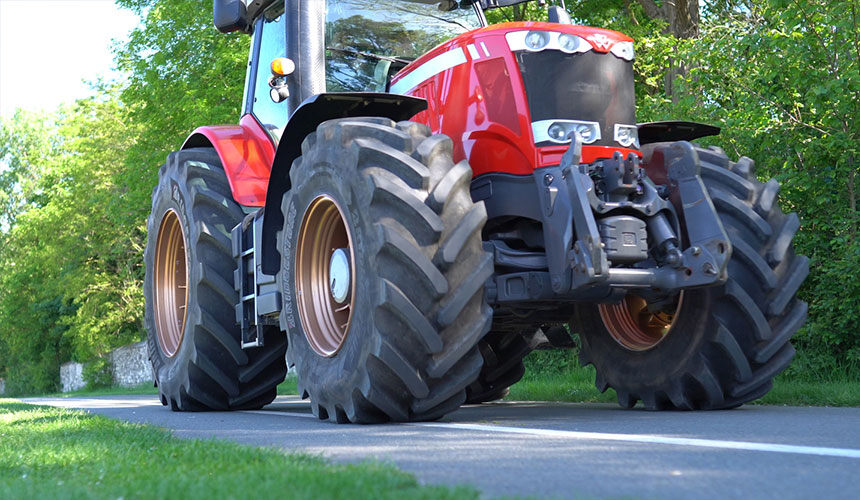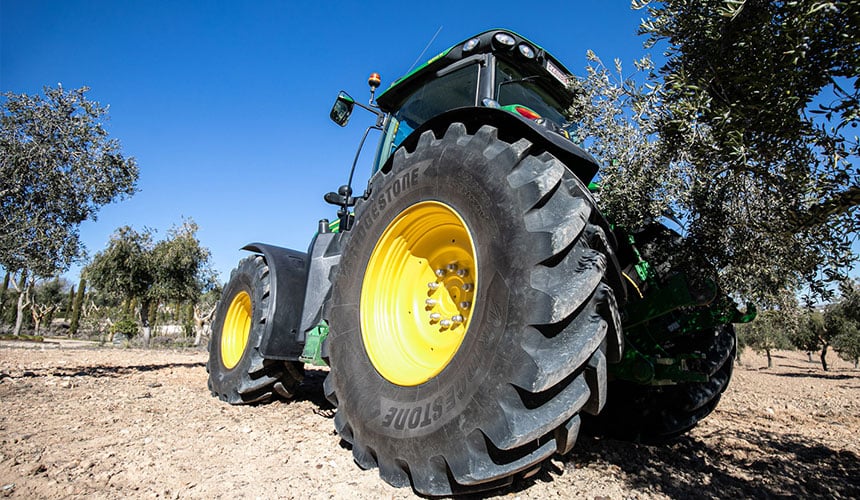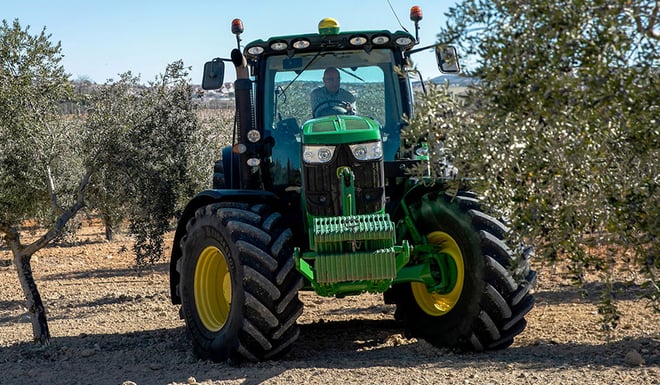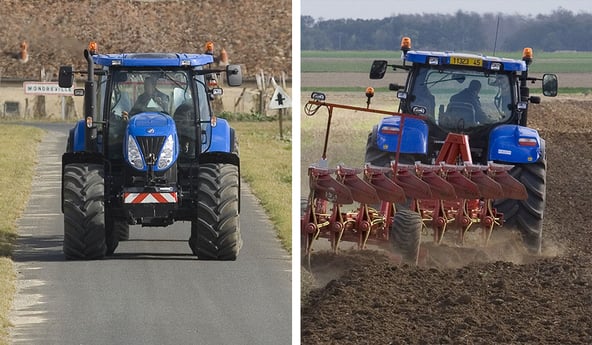Certain upmarket tyre models really help you reduce your hourly cost. They offer a much better return on investment than low-end tyres.
Superior quality tyres contribute towards improving your productivity by reducing slip, decreasing fuel consumption and limiting premature tyre wear.
A discount tyre will have a shorter lifespan for the same use, which means that the cost of replacement will double your initial investment, thus making a nonsense of the purely economic strategy.
The reality is that the quality of your tyres is crucial in terms of reducing your hourly cost and being able to consider your agricultural tyres as an investment in the mid/long-term, rather than just a purchase cost.
In this article we look at the key points which will enable you to choose the tyre which has the best hourly cost for your farm:
1. Attenuate the causes of wear linked to use
To reduce hourly costs, bear in mind that unsuitable use of the tyres will have negative effects, irrespective of the quality of the tyres.
So before looking for a tyre model that will allow you to double the number of hours of use, you should pay attention to the following points:
Ensure tyres are kept in good mechanical condition
Agricultural tyre wear may be caused by mechanical problems, in particular various geometry faults for which you must:
1. Check for problems with parallelism
Problems with parallelism occur when all the wheels are not perfectly parallel to the direction of travel.
This type of misalignment is frequent and often caused by a minor impact to the wheels, such as driving over a pothole, a rut or merely travelling on paths that are in a poor state of repair.
In general, the wear is limited to one side of the wheels.
2. Check camber
This is the incorrect alignment of the wheel in relation to the true vertical. It generally occurs after the tyres have been replaced.
There are two types of problem with camber:
- Positive camber: the top of the wheel tilts outwards from true vertical. The wear is therefore more pronounced on the outer part of the tyre.
- Negative camber: the bottom of the wheel tilts outwards from true vertical. There is more wear to the inside edge of the tyre.

3. Check the lead ratio
The lead ratio corresponds to the synchronisation of the front and rear axle of the tractor based on the size of the tyres.
A correct lead ratio is between 1.5% and 3.5% and provides slightly more front traction than at the rear.
An incorrect lead ratio, on the other hand, generally leads to premature wear to your front tyres if the lead ratio is too low or negative (lag), and wear to your rear tyres if it is above 5%.
Remember to adjust tyre pressure regularly
Depending on whether you drive on the road or in the fields, the pressure in your tyres must be different. Incorrect pressure settings can cause rapid wear to your tyres.
These are the two most common scenarios:
- Underinflation
In the fields, working at a low inflation pressure is beneficial if you are looking to avoid excessive soil compaction, whereas on the road insufficient pressure increases rolling resistance and causes abrasion to the rubber. In certain cases, at high speed, the rubber compound may overheat causing damage to the internal structure of the tyre. - Overinflation
When you work in the fields, excess inflation leads to premature tyre wear. An overinflated tyre sinks deeper into the ground and will have a tendency to slip, especially in wet conditions or on loose soil.
Avoid too much weight for your tyres’ load capacity
Each agricultural tyre model is designed to carry a clearly defined load.
The load index is indicated on the tyre’s sidewall as is the speed rating. You must follow this load index if you don’t want to weaken the tyre’s resistance and damage it rapidly.
If the load is too high, you will be obliged to increase the inflation pressure as much as possible to compensate, which will result in more slip and rapid wear to the tread.
Avoid unsuitable uses
Certain uses are not appropriate for your tractor, and have an influence on tyre wear:
- Use on the road most of the time
On the road with a heavy load, your tyres will wear much more quickly because of the road surface which is much more abrasive than earth. - Overly harsh use of the tyres
Avoid regular on-the-spot manoeuvres in the farm courtyard, working in quarries or areas with very abrasive soil, to reduce the knocks and impacts which could reduce the useful life of your tyres. - Reduce speed
Reduce speed on the road to extend your tyres’ lifespan. Speed effectively has a direct effect on wear to the rubber of the tread. In addition, compression of the load associated with the speed causes overheating of the internal structure of the tyre, which can reach temperatures of above 60 degrees. So reducing speed allows you to limit overheating and damage to the casing.

2. Choose a tyre designed to resist wear
Agricultural tyres are designed by nature for work in the fields and not for prolonged use on asphalt or for construction work.
However, many tractors are used to do a wide range of differing tasks and sometimes work that is difficult for the tyres.
In this case, give priority to top range tyres specifically designed to resist intensive use on the road as well as in the fields.
Give priority to the solidity of the casing
You must chose a tyre that is built using a robust casing designed to minimise internal strain and offer durability and resistance when used for harsher tasks than working in the fields.
This tyre must be able to cope with a higher inflation pressure and therefore heavier loads.
The tread belt and the sidewall area must be reinforced and contain more plies than are used on average in the production of standard tyres.
Choose upmarket tyre ranges designed using quality materials
The quality of an agricultural tyre is not linked to a price or a known brand, but is determined by major manufacturing differences.
The quality materials used to produce top-of-the-range agricultural tyres offer better resistance to wear, to perforation and cuts, greater flexibility, better driving comfort, tractor stability, soil preservation and safety on the road.
A high quality agricultural tyre is therefore the fruit of a complex assembly of highly specific materials, providing maximum longevity and optimal productivity.
These are the important points to check when it comes to replacing your tyres:
A large portion of natural rubber
Natural rubber is the basic ingredient of the rubber compound used to produce upmarket tyres and has excellent resistance, elasticity, impermeability and adherence characteristics.
Synthetic rubber produced through hydrocarbon processing is added.
This improves the resistance of the rubber once it has been mixed with the natural rubber.
High-end tyres contain styrene butadiene to strengthen the abrasion resistance of the tread and butadiene to increase the sidewalls’ resistance to impacts.
The right additives to improve performance
Certain manufacturers save on additives in order to produce discount tyres. Yet these elements are essential for improving the quality of the tyre.
They are used for shaping, resistance to temperature, improvement of the vulcanisation process. Top range tyres use more additives, such as carbon black which increases the mechanical resistance of the rubber, or zinc oxide to resist raised temperatures and sulphur to give the rubber its elasticity.
The additives make the tyre ultra-resistant to wear to prolong its useful life by thousands of hours.
A multi-layer assembly of fabrics for resistance
The secret of agricultural tyre resistance does not lie solely in the quality of its constituent materials; the highly technical assembly of its components, in particular the fabric chords, is also very important.
These fabric chords are made preferably from nylon, polyester or rayon to strengthen the internal structure of the tyre, while keeping its suppleness.
The overlapping plies or chords ensure impact resistance.
The tread is made up of numerous cross-stabilising plies on top of the casing protection plies. These plies allow the tyre to work over its full width and maintain perfect steering control.
The difference in price between tyres comes from reducing the number of plies to a minimum in discount tyres.
3. The VX-TRACTOR tyre is ideal for reducing your hourly costs
The VX-TRACTOR tyre is a superior quality tyre developed specifically to resist the different demands of all agricultural activities.
By opting for this type of tyre, you will obtain many benefits, the main one being an exceptional tyre lifespan.

One of the lowest hourly costs on the market
One of the main advantages of the VX-TRACTOR tyre is its low hourly cost.
It has around 20% more rubber on its tread.
It is equipped with longer, wider lugs. This increases its traction capacity on all types of soil, in all weather conditions.
Its lugs are also more resistant to wear, giving them a longer useful life, even when used intensively on the road. They also help to reduce the slip ratio, leading to lower fuel consumption during work in the fields.

The addition of a wear-resistant compound to extend the tyre lifespan even further
The VX-TRACTOR tyre tread is designed to last even longer.
It is produced using several additives in its rubber compound, in particular a portion of specific vegetable oil that is higher than for other models in order to improve its efficiency:
- Wear resistance increased by 30%
- Cut resistance increased by 5%
The VX-TRACTOR tyre is definitely more economical than discount tyres
To summarise, the VX-TRACTOR tyre represents 100% more working hours than a standard tyre, with a selling price that is not double that of its standard counterpart, meaning that its hourly cost is much lower.
Discount tyres have a shorter lifespan, which increases the cost of replacement and disproves what is perceived as a cost-effective strategy.
To learn more about ways to increase your farm’s productivity, bridgestone-agriculture has created a comprehensive eBook on the topic which is available for you to download for free:
Bridgestone-agriculture Blog is written and administered by tractor tyre experts who are available to provide you with advice on agricultural tyres. They will help you to maximise your productivity with information on all things relating to tyres: inexpensive tractor tyres, technical data for agricultural tyres, solutions for avoiding soil compaction, sprayer tyre pressure, why and how to ballast your tractor tyres, when to use dual-wheels, the mechanical causes for abnormal wear, discounted agricultural tyres, etc.
Most people who read this article have also read some of the following articles:
- 10 tips to reduce abnormal wear to your farming tyres
- Testimonial: are there agricultural tyres more resistant to wear?
- Can a hernia on my tractor tyre be repaired?
- Repairing tractor tyres: the techniques for each situation
- When can you carry out cold repairs on tractor tyres?
- 5 problems on the bead of an agricultural tyre which mean it has to be replaced
- Does unsuitable inflation pressure accelerate wear to my agricultural tyres?
- What are the 4 top stress factors for your agricultural tyres?
- What impact does stubble have on my tractor tyre wear?
- Why don’t my agricultural tyres last long enough?
This information is intended only to make you aware of the technical and functional aspects of agricultural tires and their use. It does not allow you to make a judgment or a definitive conclusion on a given problem. Only your agricultural tire expert is able to make a technical assessment and take a final decision, case by case.
Leave a
commentary
Your email address will not be published.
Required fields are indicated with *








